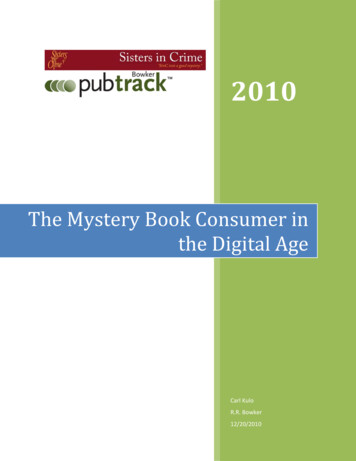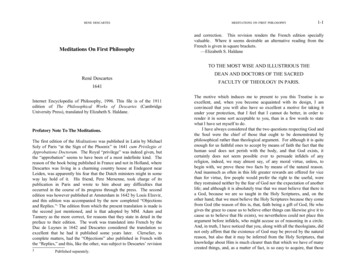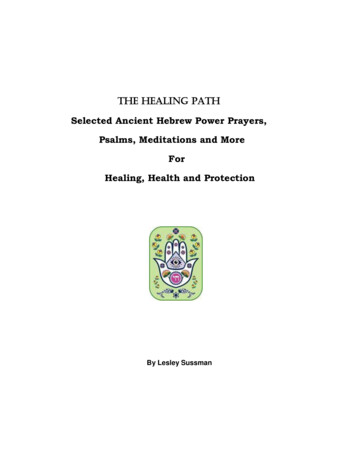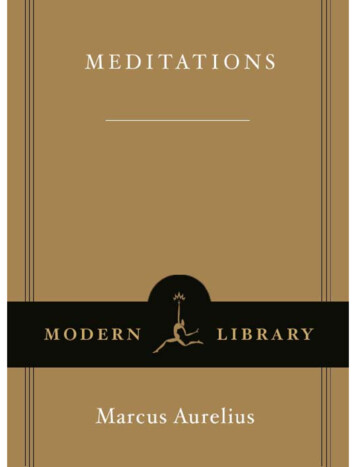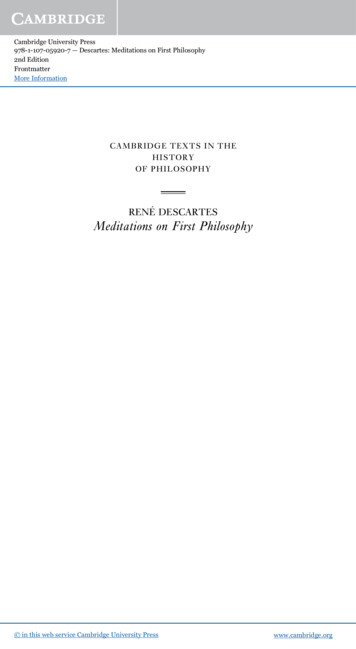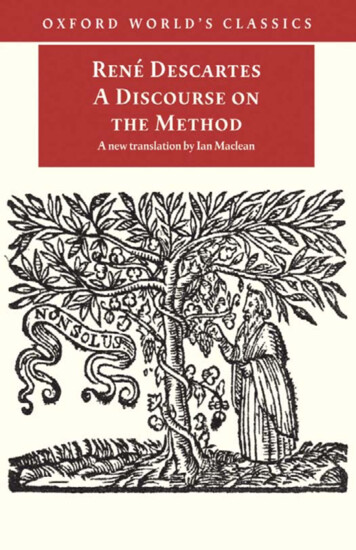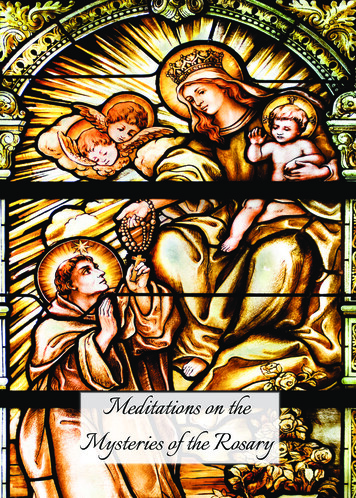
Transcription
Meditations on theMysteries of the Rosary
Nihil Obstat: Father Alfred Wilder, O.P., Ph.D.Censor LibrorumNovember 20, 2015Imprimatur: David R. Choby, D.D., J.C.L.Bishop of NashvilleDecember 3, 2015The Nihil Obstat and the Imprimatur are official declarations thata book or pamphlet is free of doctrinal and moral error. No implication is contained therein that those who have granted the NihilObstat and the Imprimatur agree with the opinions expressed. 2016 by St. Cecilia Congregation, LBP CommunicationsDominican Sisters of St. Cecilia Congregation801 Dominican DriveNashville, Tennessee 37228-1909
MeditationsontheMysteriesof theRosarycomposed bySister Mary Madeline Todd, O.P.
January 1, 2016“Hail Mary, full of Grace!”It is fitting that we celebrate this 800th Jubilee of the Orderof Preachers with a renewal of our devotion to the HolyRosary of Our Lady. This long-familiar prayer, whichengages our minds, our hearts, and our bodies, is a meansof deepening our relationship with her who is both ourmother and protector. As Dominicans we wear this rosaryat our side; we pray it in community and in private, andwe cling to it before sleep at the end of the day. The rosaryis placed in our hands at “the hour of our death,” and itaccompanies us at burial, in the “Amen” of earthly life.Always, Our Lady takes us to Jesus. Pondering with her themysteries and wonders of her Son is foundational to growthin our relationship with Him. The rosary is our weapon inthe battle against evil, a visible sign of the protection of theMother of God and a constant call to fidelity as we navigatea new and widespread secularism and materialism.During this 800th Jubilee of the Dominican Order may wefind new ways to bring the rosary, this gift of Our Lady, tothe people of our time.“Holy Mary, Mother of God, pray for us sinners now, and atthe hour of our death.”In Mary Help of the Weak,Mother Ann Marie Karlovic, O.P.Prioress General of the Dominican Sistersof St. Cecilia Congregation
The images in this booklet are photographs of stained glasswindows in the exonarthex of the Chapel of St. Cecilia atthe motherhouse of the Dominican Sisters of St. Cecilia,Nashville, Tennessee. Based on engravings by AlbrechtDürer and Hans (Leonhard) Schäufelin (Schäufelein), theserosary windows were crafted by the Franz Mayer Studios inMunich, Germany, using the grisaille technique.
IntroductionAs the Order of Preachers celebrates the 800th anniversary ofits approval by Pope Honorius III on December 22, 1216,we thank God for the graces He has bestowed on and throughthe Dominican family. Among these is the call to promote therosary as a means of contemplating the mystery of Christ as therevelation of the Father’s love.While the rosary, in the form in which we pray it today,has developed over centuries, it is fitting that it was entrusted tothe family of Saint Dominic to promote in a special way. SaintDominic tirelessly meditated on the Word of God, and he haddeep devotion to Mary as Mother of Christ and Mother of theChurch and of his Order.Pope Saint John Paul II summarized well theChristocentric and Mariological character of the rosary, in hisapostolic letter, Rosarium Virginis Mariae, “With the rosary,” hewrites, “the Christian people sits at the school of Mary and is ledto contemplate the beauty on the face of Christ and to experiencethe depths of his love.”1 Later in the letter, he notes that theDominican Order has highlighted the proclamation of the truthof Christ especially at times when error has abounded, and heaffirms the perennial value of the rosary for evangelization.On January 1, 2008, Father Carlos Azpiroz Costa,Master General of the Order of Preachers, called for a renewal ofthe prayer and preaching of the rosary, especially in light of theJubilee of the Order. He writes, “I am proposing that we begin torenew our preaching way of life through re-discovering the rosaryas a means of contemplation and an instrument of propheticpreaching.” In the course of the letter, he develops his proposal,focusing on the aspects of memory, theological reflection, andpopular religious practice. He highlights the ways in which thegraces we ponder in the lives of Jesus and Mary are not mere
historical reflections, but rather portraits of the presence ofGod in every moment and every person – alive and acting inand through us. He writes, “The mystery of the Incarnation isnot only about the birth of the Lord in millennia past, but aboutthe incarnation of grace, or the birth of God, in our own dailylives. Jesus lives and His Spirit continues to heal, teach, forgive,comfort and challenge us. This is not an empty abstraction, butrather is made visible in and through the images associated withthe mysteries of the rosary.”Many tools have been developed to aid the faithful inpraying the rosary. This booklet offers meditations based first onthe Word of God, drawn especially from the Gospels and theLetters of Saint Paul, the wellsprings from which Saint Dominicconstantly drew the waters of his own contemplation. In additionto the Scriptures, these meditations include thoughts from thewritings of the saints of the Order of Preachers, namely SaintThomas Aquinas and Saint Catherine of Siena. Like our holyfather Dominic, they found in meditating on the Word MadeFlesh a constant source of grace and inspiration. Finally, thesereflections likewise offer an invitation to pray for the divine giftscentral in the teaching of Saint Thomas Aquinas – the theologicaland cardinal virtues, and the gifts and fruits of the Holy Spirit –the gifts freely bestowed on us by God in Baptism, by which webecome ever more conformed to Christ.
Mary was ayoung woman of faith,who trusted inGod’s wordbecause she believedin Godwith all of her being.
Joyful Mysteries
First Joyful Mystery – The Annunciation(Luke 1:26-38)The Theological Virtue of FaithWe know the story so well that we can forget how astonishingit would have been for a simple girl from a humble villageto be asked to become the mother of the Son of God. The angelGabriel announces to Mary, “Behold, you will conceive in yourwomb and bear a Son, and you shall name him Jesus The HolySpirit will come upon you, and the power of the Most High willovershadow you. Therefore the child to be born will be calledholy, the Son of God.”2 Amidst the surprise and wonder that suchnews would awaken in her heart, Mary was a young woman offaith, who trusted in God’s word because she believed in Godwith all of her being.Faith, according to the Letter to the Hebrews, is “therealization of what is hoped for and evidence of things not seen.”3Mary believed that God could fulfill his promise, not because shecould see clearly every step of the journey, but because she freelysurrendered herself to the One whose identity and plan werebeyond her understanding, yet worthy of her trust. Saint ThomasAquinas writes, “Just as the Blessed Virgin conceived Christ inher body, so every pious soul conceives Him spiritually.”4By the virtue of faith, we believe in God as First Truth,and we believe all that He reveals because of our faith in Him.Saint Thomas distinguishes lifeless faith from living faith by itsunion with charity.5 Saint Catherine notes of the soul surrenderedto the Holy Spirit, “Because she has put no trust in herself she iscrowned with living faith and fulfilled hope.”6 May we be opento living faith like that of Mary, ready to welcome God’s wordwith belief and love, echoing her response, “May it be done to meaccording to your word.”7
Second Joyful Mystery – The Visitation(Luke 1:39-56)The Spirit’s Fruit of KindnessOne who has the grace of God within does not remain closedin self-concern. Mary, full of grace and bearing Christwithin her, could not fail to go out of herself in response to theneeds of her elderly relative, Elizabeth. Knowing that Elizabethhad, by God’s great kindness, been granted the gift of a child,“Mary set out and traveled to the hill country in haste to a townof Judah, where she entered the house of Zechariah and greetedElizabeth.”8 She remained there for three months, generouslyserving, so that Elizabeth could welcome her child in peace andsecurity.God is the source and pattern of all kindness. Saint Paulwrites to Titus: “But when the kindness and generous love of Godour Savior appeared, not because of any righteous deeds we haddone but because of his mercy, He saved us through the bath ofrebirth and renewal by the Holy Spirit, whom He richly pouredout on us through Jesus Christ our Savior, so that we might bejustified by his grace and become heirs in hope of eternal life.”9Kindness is among the fruits of the Holy Spirit that SaintPaul lists in the Letter to the Galatians.10 Saint Thomas Aquinasexplains that when the Spirit moves in persons, the fruits of thisaction are evident in the delight they find in good acts. Thosewho show spiritual kindness, he writes, are those in whom thefire of love “has kindled the desire to be kind to their neighbor.”11God the Father says to Saint Catherine of Siena, “The service youcannot render me you must do for your neighbors. Thus it willbe evident that you have me within your soul by grace.”12 Maywe witness to God in us by reaching out with kindness to thosebefore us.
Mysteries of the Rosary compo

